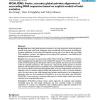294 search results - page 6 / 59 » Evolution of Fitness Functions to Improve Heuristic Performa... |
BMCBI
2006
13 years 7 months ago
2006
Background: Non-coding DNA sequences comprise a very large proportion of the total genomic content of mammals, most other vertebrates, many invertebrates, and most plants. Unravel...
ASPDAC
2008
ACM
13 years 9 months ago
2008
ACM
This paper proposes a novel Behavioral Synthesis method that improves performance of synthesized circuits utilizing specialized functional units effectively. Specialized functional...
NN
2000
Springer
13 years 7 months ago
2000
Springer
We address two issues in Evolutionary Robotics, namely the genetic encoding and the performance criterion, also known as fitness function. For the first aspect, we suggest to enco...
CPAIOR
2008
Springer
13 years 9 months ago
2008
Springer
Solution-Guided Multi-Point Constructive Search (SGMPCS) is a complete, constructive search technique that has been shown to out-perform standard constructive search techniques on ...
CSDA
2006
13 years 7 months ago
2006
We explore different approaches for performing hypothesis tests on the shape of a mean function by developing general methodologies both, for the often assumed, i.i.d. error struc...

